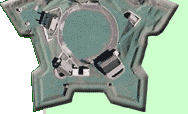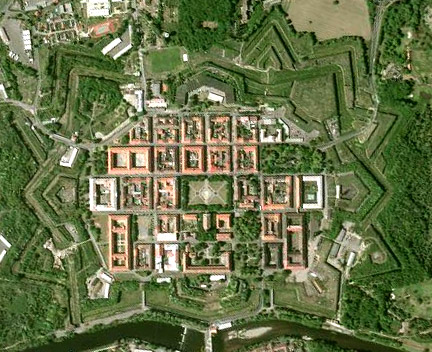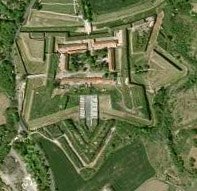
 |
 |
Terezin Czech Republic |
 |
 |
   |
 |
 |
||
 |
Towards the end of the 18th century, the Habsburg Monarchy came to the conclusion that they needed a cool fort to name after Marie Theresa (1717-1780), the one and only female Habsburg ruler. The confluence of the Labe and Ohre rivers in what is today the Czech Republic (but was then part of the vast expanse of Austria-Hungary) presented itself as an excellent spot for such a fortification, and construction began in 1780. It was hoped that Terezin would help to deflect invading northern hordes from attacking Prague. Terezin was designed to mimic the creations of Vauban, and was completed in 1790, with a cute little offshoot fortlet built just across the Labe river, connected by a road. The fort held just under 6,000 soldiers in peacetime, but could house as many as 11,000 in time of war: a flood of Habsburgian justice just waiting to drag your backside back into the Austro-Hungarian fold. Or kill you. And possibly burn down your village. Terezin never performed its intended function of heroically withstanding attack and/or seige, but troops based at Terezin did participate in the Austro-Prussian War (1866). Sort of. On July 28 1866, part of Terezin's garrison headed southeast to attack and destroy an important railway bridge at Neratovice, just north of Prague. This daring feat took place two days after Austria and Prussia had agreed on peace terms, the former having had its collective butt kicked by the latter in the Battle of Koniggratz on July 3. Communications being what they were in 1866, Terezin had been unaware that the war was over. By the end of the 19th century, Terezin was being used as a prison. During the First World War (1914-1918), the prisoners held at Terezin became more political in nature: Thousands of supporters of Russia were gently placed there by Austro-Hungarian authorities. Terezin's celebrity prisoner was Gavrilo Princip (1894-1918), the man who lit the spark that started the Great War by asassinating the Archduke Franz Ferdinand (1863-1914) on June 28 1914. Princip died on April 28 1918 at Terezin, suffering from tuberculosis brought on by conditions at the prison, malnutrition and blood loss from an amputated arm. Princip weighed in at a healthy 88lbs at the time of his death. The Austro-Hungarian Empire, and really the Habsburg Monarchy, was dumped on the trash heap of history at the end of the First World War. Czechoslovakia declared its independence from Austria-Hungary on October 18 and became the only central European state that came to being at the end of WWI to have and preserve a democratic form of government. A vicious little man with a vicious little moustache put an end to that nonsense in 1938 by annexing the Sudetenland, and then, dispensing with political niceties, invaded the rest of Czechoslovakia in 1939. As Hitler (1889-1945) began collecting Jews from the lands the nazis were rapidly rolling over at the beginning of the Second World War (1939-1945), Terezin was a Gestapo-run concentration camp (named Theresienstadt), though not in the sense that such odious places as Auschwitz were concentration camps. Word was spread far and wide that good ole Adolph had built a city for the Jews, to protect them from the "vagaries and stresses" of the war. Terezin served as a waypoint (really a ghetto) for around 150,000 Jews from Czechoslovakia, Germany, Austria, the Netherlands and Denmark. Some 88,000 went on to real concentration camps, with predictable results. Conditions in the camp were abysmal, with many dying from malnutrition and related ailments. Theresienstadt also served as a punishment camp for Allied prisoners of war who had made numerous escape attempts from other POW camps: Prisoners from Australia, New Zealand, England and Scotland were kept at the camp. Though better treated than the Jews, the POWs still suffered plenty of deprivation, and many came away from their experience with chronic physical and/or mental damage. The smaller ofshoot fortlet of Terezin was used as the area's Gestapo prison, wherein some 2,600 people died during the war. The Red Army liberated Terezin on May 9 1945. U! S! S! R! The day after Terezin was liberated, the first ethnic Germans arrived for imprisonment there. The first new prison commander took a rather liberal stance on brutal behavior, and the internees were tortured and/or murdered at the whim of the guards, but by 1946 Terezin's prisoners were moved to Germany. Czechoslovakia was peacefully dissolved into the Czech Republic and Slovakia in 1992. A military garrison remained on duty at Terezin until 1996, leaving what had been a garrison town for 120+ years to wonder what on earth it should do now. By most accounts, it still has very little idea. |
 |
 |
||
|
|
|||||||
Info Source 1
Info Source 2
Info Source 3
Info Source 4 Info Source 5 Info Source 6 Info Source 7 Info Source 8 Info Source 9 Info Source 10 Thanks to Google Maps for the images! ©2010 starforts.com |
 |